The Best Women’s Ski Jackets of 2024
This article originally appeared on Outside
One of the best ways to guarantee the best possible day skiing is to have clothing to keep you comfortable on the slopes, and a great ski jacket tops that gear list every time. A jacket that keeps you warm and dry, one that lets you move comfortably and naturally, and one that makes you look good will make you feel good on the slopes. It's true, a killer jacket will boost your confidence and help you ski your best too. Whether you're on a budget or ready to splurge, this season's women's ski jackets are the softest, sleekest, most functional and comfortable we've seen. And many now have a great eco story, so you can feel good about what you're wearing.
The Winners at a Glance
Editor's Choice: Mammut Haldigrat HS Hooded Jacket
Best Technical Shell: Stio Figment Jacket
Most Eco-Friendly Shell: Picture Queya 3L Jacket
Best One-Quiver Shell: Ortovox Guardian 3L Shell
Best For Women Who Are Always Cold: Black Diamond Insulated Jacket
Best Value: Montec Moss Jacket
Best For Cold Temps: Orage Grace Insulated Jacket
Most Tailored: Rossignol Rallybird Jacket
Best Rear Coverage: Mountain Hardwear Powder Maven Parka
Best Anorak: Outdoor Research Snowcrew Anorak
The Reviews: The Best Women's Ski Jackets of 2024
Editor's Choice: Mammut Haldigrat HS Hooded Jacket ($629)
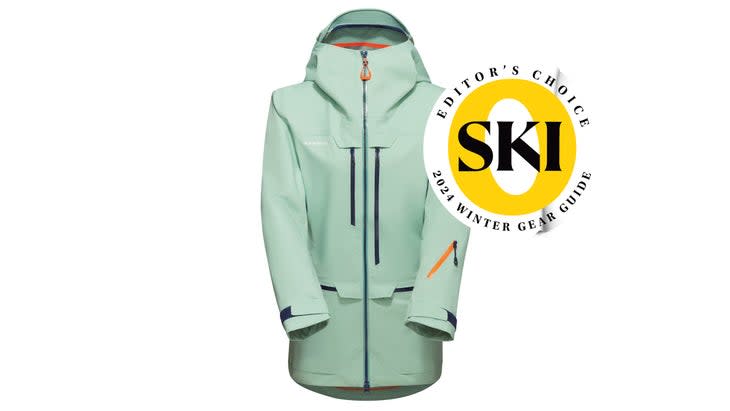
Weight: 1.4 lb
Sizes: S-XXL
Pros
High-cut neck with a fleece liner
Extra large chest pockets
Cons
Single skin pocket not big enough to fit all skins
"This jacket is everything you need and nothing you don't," said Vermont tester Kerry Douglas Pearce. With a freeride cut, light and durable Bluesign-certified recycled fabric, and tasteful color hits, testers couldn't clock enough ski days in this jacket. "I love the Haldigrat's slightly longer length and how it meshes so well with the matching bib pants," said tester Louise Lintilhac. "The light weight made it a great choice for warmer weather adventures, but because it's so flexible and has a lot of good stretch, it's easy to stack warm layers underneath for added protection against the cold."
The high neck was superb at blocking wind on the coldest days. And we loved the Lycra cuffs that weren't too tight but still kept the snow out. Mammut hid the hem cinch in tiny sewn-in pods that kept the pull cords retracted. And the powder skirt zips out when you don't need it. The helmet-compatible hood also has a pull cord adjustment as well as an inner mesh visor that kept the hood from sliding over our eyes when we had it deployed while we were skiing.
Zippers are burly but flexible, and testers appreciated the pockets, including two oversized chest pockets, two oversized hand pockets, and an internal phone pocket. All were easy access. Elbow-to-hip pit zips enhanced airflow as needed. But the jacket was extremely breathable even when fully zipped. The Haldigrat is a great choice for skiers who are happy to layer, and who want a shell that's light enough for spring skiing. We were all big fans of the recycled and fair wear certifications.
Bottom line: The perfect freeride kit for anyone looking to do front, side, and backcountry. If you can't make up your mind about what you want to do for the day, this is the kit for you.
Best Technical Shell: Stio Figment Jacket ($499)
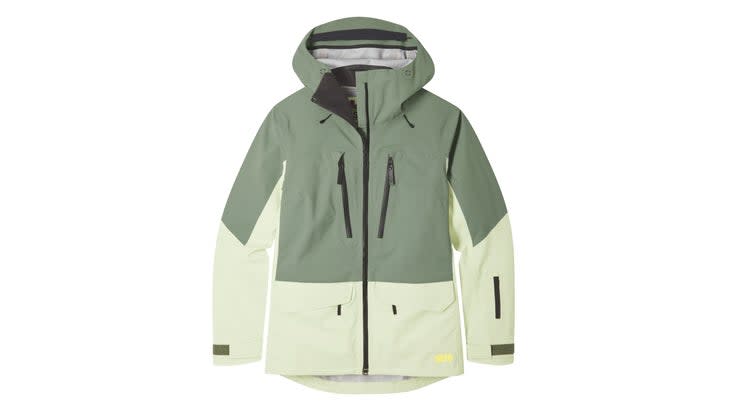
Weight: 1.7 lb
Sizes: XS-XL
Pros
Burly without being stiff
Cool color blocking
Cons
Some pockets overlap so they're not usable at the same time
Slip into this shell jacket, and you feel like the weather can't touch you. The Figment's 100-percent recycled exterior fabric excelled at fending off wind chill, and at keeping us comfortable from bump runs to the skin track. While the shell material is tough, it's highly breathable and not overly heavy. We wore this jacket resort skiing, touring, and everything in between in sub-freezing to sub-zero temps in Jackson and Vermont. Skiing steep trees at Jackson Hole, the jacket's helmet-compatible hood, which has a bonded brim to seal out the elements, came in handy when we dropped in with whipping wind coming at us from the side. Traversing out of Granite Canyon in the spring sunshine, the pit zips proved easy to operate one-handed.
The jacket has a clean cut with hidden cord locks at the front and peripheral hood adjustments, and a bonded flap that conceals the cord lock at the back of the hood. Brushed fleece inside the collar and on the chin guard were soft and cozy and made this shell feel warm on the coldest days. The two-way water-resistant main zipper is cleverly designed with the draft flap on the inside to prevent zipper gaping and to keep this jacket's lines clean. The chest pockets, sleeve pockets, and pit zips all use water-resistant zips. They were pliable, not stiff, and easy to operate. I stashed my phone in the easily accessible mesh media pocket inside the left chest pocket. Zippered hand pockets with flaps held snacks and a spare buff.
Bottom line: A highly weatherproof technical shell with a relaxed look and fit that can handle anywhere and everywhere you ski
Most Eco-Friendly Shell: Picture Queya 3L Jacket ($580)
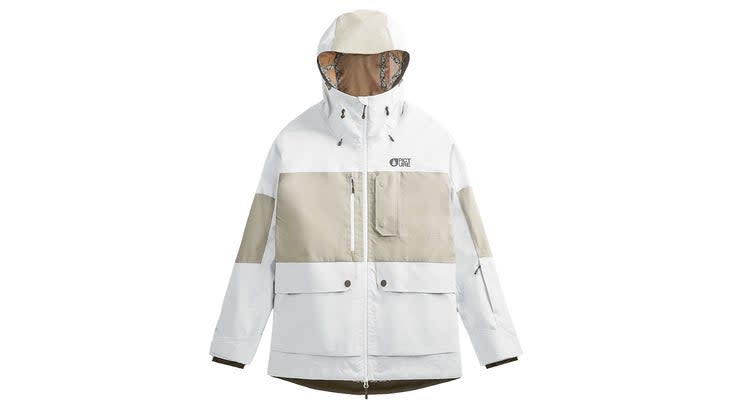
Weight: 1.7 lb
Sizes: XS-XL
Pros
Super-soft fabric
Excellent pockets
highly breathable
Cons
Lycra thumb loop inner cuffs were tight on some testers
No internal pockets
"I put this jacket on, and it felt and looked so good, I didn't want to take it off," said Idaho-based tester Michelle Nicholson. The Queya 3L's long, freeride cut gave us plenty of room to move and room to layer, and it had a flattering shape that worked for women of all dimensions.
Besides the delicious feel of the soft, stretchy, silent fabric, we all loved how well it breathed, and that for sunny days when we were skiing hard we could also vent the jacket with pit zips. Vermont tester Caitlin Kelly appreciated the extra-wide sleeves, which have glove-friendly velcro tighteners, and even allowed even bulkier gloves to slide underneath. Contrasting elbows and mid-torso panels gave this jacket a subtle but eye-catching style. So did the mountain-print seam tape on the inside.
The pockets were also awesome. The Queya 3L has sandwich-sized chest pockets, including one with a magnetic flap over the zipper. Top flap hand pockets have waterproof zippers too. On deep days, we appreciated that the removable powder skirt had loops that mate with Picture pants to turn your kit into a onesie. We pulled up the adjustable helmet-compatible hood to shed snow and wind. A zip ski pass pocket on the lower left arm kept us cruising through the lift line without a hitch. This jacket was also a huge win for being kind to the planet. It's made from 100 percent circular polyester, which uses existing pre- and post-Consumer waste to save significant amounts of CO2.
Bottom line: The most environmentally friendly jacket you can buy with a unique style all its own
Best One-Quiver Shell: Ortovox Guardian 3L Shell ($820)
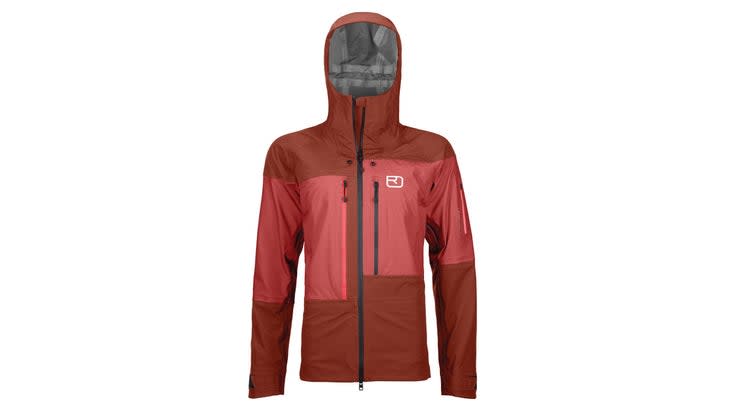
Weight: 1.6 lb
Sizes: XS-XL
Pros
Wicking
Temperature regulating Merino lining
Cons
Expensive
While this is the priciest jacket we loved of the ones we tested, multiple testers said they'd invest in it because it's so comfortable, well-made, and it was so good at keeping us warm. Plus it didn't get stinky no matter how many days we skied in it. The stretchy outer membrane is wind- and waterproof. It's also highly breathable. Paired with the sweat and stink-controlling inner lining, it was a near-perfect system. Utah-based tester Abby Ghent said, "The Merino lining makes the shell feel more cozy, and paired with the membrane this jacket wicked sweat better than any other I tested. I never felt clammy in this shell."
The polyamide shell and Dermizax EV membrane never felt stiff or crinkly even when skiing bumps in below-zero temps at Vermont's Sugarbush Resort. Pockets are positioned so that when testers wore this jacket with a pack for slackcountry, sidecountry, and backcountry, there was no need to rearrange gear to get it out of the way of pack straps. Ortovox gave this jacket mountaineering-worthy features: a two-way adjustable storm hood, and a removable snow skirt. We especially liked the Merino mesh inner pocket inside the left chest pocket as well as the small zippered pocket on the inside of the right chest. "These pockets were good for storing your beacon and phone far enough away from one another while still leaving some room for snacks and other things," said Ghent.
For a lot of testers, this jacket hit the sweet spot for warmth and insulation. "Definitely catered towards the backcountry skier who could encounter any kind of weather, as long as they have proper layers...it was also a great spring jacket or warm weather jacket," said Nicholson. "Skiing off Jackson Hole's gondola, I was grateful for its protection on a very windy and exposed slope" Thanks to its robust membrane and flat seams, this freeriding jacket is particularly durable and long-wearing. It is also PFC-free and climate-neutral: Ortovox's Merino comes from monitored, ethical sheep farms.
Bottom line: Bombshell jacket that takes the weather head on and still looks and feels good.
Best For Women Who Are Always Cold: Black Diamond Insulated Shell ($480)
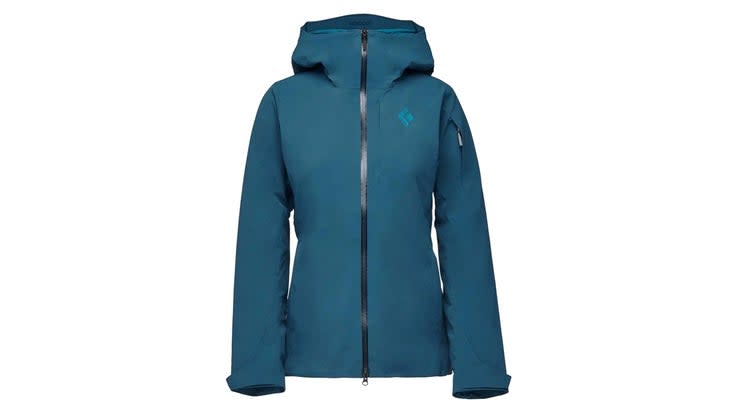
Weight: 1.6 lb
Sizes: XS-XL
Pros
Stretchy and moveable
Warm enough without being too warm
Cons
No internal phone pocket
Pass pocket is on the shoulder, not the sleeve
Cozy, breathable, comfortable, and warm. When a dozen testers all say a jacket is one they'd buy, you know you found a winner. "I liked the slimmer cut and longer hem length and the stretchiness made that possible without feeling Constricted," said Jackson-based tester Eve Barnett. The understated jacket uses a proprietary nylon stretch woven shell and a versatile 60 grams of 100 percent recycled insulation that gave testers wind and weather protection that was perfect for lift rides and that didn't feel sweaty on descents.
The jacket utilizes zoned insulation to trap body heat in key areas while remaining breathable in zones where you're prone to overheating. "When I got off the lift and the typical gusts were kicking up, the quality of windproofing was really apparent," said tester Bec Wojtecki. "This jacket kept out the usual chill that sweeps through me on the blustery summit."
The jacket is simple and streamlined with a single chest pocket for essentials, and two internal mesh drop pockets for skins, sunnies, extra gloves, a pass pocket, and hand pockets. The removable powder skirt was great on days when it was deep. Other days, it stayed out of the way. Pit zips provided venting when needed. A waterproof front zipper and a helmet-compatible hood added protection on storm days. The adjustable cuffs were cut wide enough to easily slide gloves underneath. And pretty much every tester appreciated this kit's low-key vibe. "I felt chic and stylish without being a poser," said Jackson-based skier Flo McCall. "I've never received so many compliments, both on the hill and on social media, as when I was wearing this kit," said tester Kerry Douglas-Pearce. "The warmth, comfort, and fit were all topnotch."
Bottom line: If you ski where it's cold and like a low key vibe, this is the jacket for you.
Montec Moss Insulated Jacket ($239)
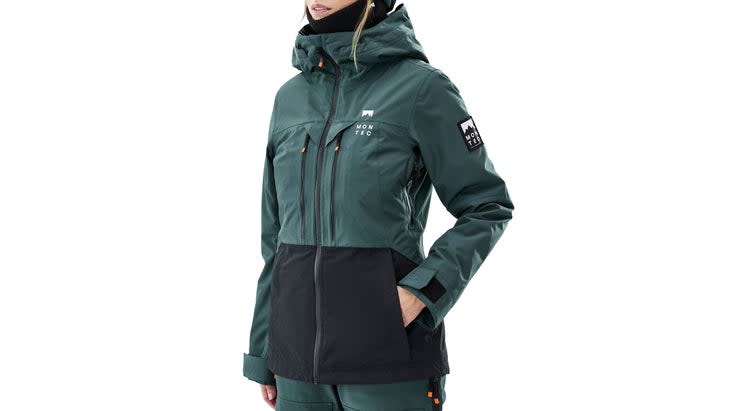
Weight: 2.25 lb
Sizes: XXS-XL
Pros
Affordable
Spacious chest pocket with inner zip pocket
Cons
Not as breathable as others
Stretchy sleeve cuffs didn't work with all gloves
There's a reason you see Montec gear in every ski resort liftline from Maine to California--it's affordable, with youthful styling and a freeride vibe. Montec's Moss Insulated jacket was a hit with our testing team across mountain ranges. We loved the medium cropped length, contoured fit, and the moderate layer of insulation. "As a fan of a more insulated jacket, this was a great weight to layer up or layer down," said tester Bec Wojtecki. "And for my curvy, medium-plus body, this coat fit perfectly. I had a lot of mobility and was comfortable layering." For a budget jacket, Montec bakes in a load of features that make the jacket versatile, including a storm-blocking hood, underarm vents, an elasticized storm skirt, long, stretchy wrist gaiters, oversized sleeve openings, and a microfleece chin guard. Wojtecki also praised the double internal chest pocket, saying, "It was the perfect place to safely stash my key fob." The jacket does have noticeable differences from its more expensive competition. The fabric wasn't as breathable as in some other jackets, the stretchy wrist gaiter sleeves were not compatible with all gloves, and the zippers were more delicate. But the price and the styling made it one of our faves.
Bottom line: A great jacket for the casual skier on a budget, and for skiers who want a great looking jacket in extended sizing.
Best For Cold Temps: Orage Grace Insulated Jacket ($500)
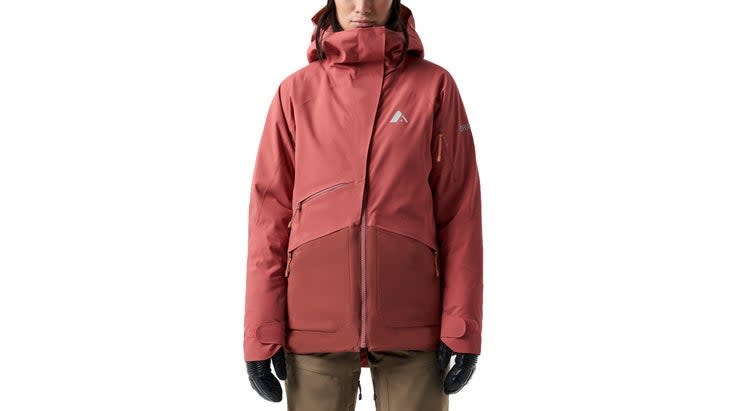
Weight: 1.8 lbs
Sizes: XXS - XXL
Pros
Muted colors
Insulation was warm but not bulky
Cons
One-way zipper
Hand pockets were hard to get into
Want to be protected from the worst of the winter weather but still hit the slopes? This is the jacket that will get you there. Tester Bec Wotejski said Orage's Grace was one of her favorites. "I loved the long length, and that this stretchy jacket had room for my curves. Plus the color scheme was natural and low key, but with fun hits of color." From Vermont to Jackson Hole, testers praised the Grace's warmth, cozy-against-the-skin lining, and low bulk. "This jacket was warmer than it looked thanks to its low-bulk insulation," said Jackson tester Eve Barnette. "I liked the low-key style and earthy colors." Cuffs were comfortable with Lycra inner sleeves worn with or without the thumb loops.
The insulated hood easily slid over a helmet without being loose and bulky. "It was easy to toss up and cinch down the three-way adjustable hood when the wind kicked up at the summit," said Wojteski. "I felt good in this jacket, both in terms of look and fit." Testers also loved the headphone port that ran from a stretchy below-the-boob pocket--which also had a phone tether--to the collar. Hand pockets were spacious, and the left one had a lanyard, but some testers found the hand pockets and the pit zips hard to fully open one-handed. Orage uses YKK waterproof zippers throughout. The inner mesh goggle pockets were roomy enough to hold lunch. The powder skirt doesn't zip out, but it does snap out of the way when not in use.
Bottom line: A long, warm, low-key, earthy-chic insulated jacket that's ready for the coldest days.
Most Tailored: Rossignol Rallybird Jacket ($420)
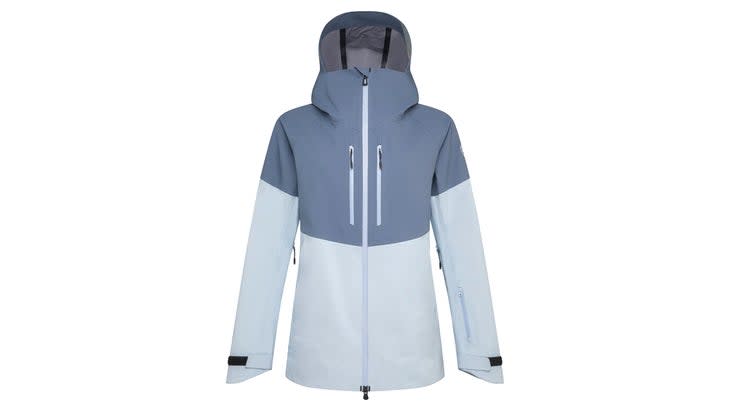
Weight: 1.5 lb
Sizes: XS-XL
Pros
Heavier fabric felt warm
Tailored fit
Cons
Internal pockets are too small for skins
Powder skirt isn't removable
Wear it tailored, wear it more relaxed. Rossignol's Rallybird is a seam-taped waterproof-breathable hardshell that feels like a softshell. It kept us warm and dry through the gamut of winter weather and temperatures from the sunny Rocky Mountains to the fjords of Norway. The three-layer jacket has weatherproof underarm zippers for venting, plus the easy-to-operate two-way zipper seals you in and away from the cold and snow.
Rossignol designers spent time thinking through the cuffs, which testers loved. They're cut long to slide over or under gloves, with an elastic thumb loop with a tab that made sliding the cuffs inside a glove easy. For skiers and riders who prefer to wear their cuffs over their gloves, we appreciated the elastic on the insides of the cuffs which helped keep the sleeves from sliding up. The jacket had functional pit zips, but they were on the shorter side. A broad fleece band where the jacket touched our faces was deliciously warm. "I loved zipping up this jacket because the soft lining of the extended collar felt so cozy on my face," said tester Bec Wojtecki.
Rossignol uses a PFC-Free Durable Water-Repellent (DWR) coating that sheds light snow and rain without the use of toxic fluorocarbon-based chemicals. Dual chest pockets, handwarmer pockets, and mesh pockets rounded out the package. It's worth noting that testers found this jacket to run large.
Bottom line: A stretchy, warm shell for the skier who prefers a more fitted jacket.
Mountain Hardwear Powder Maven Parka ($379)
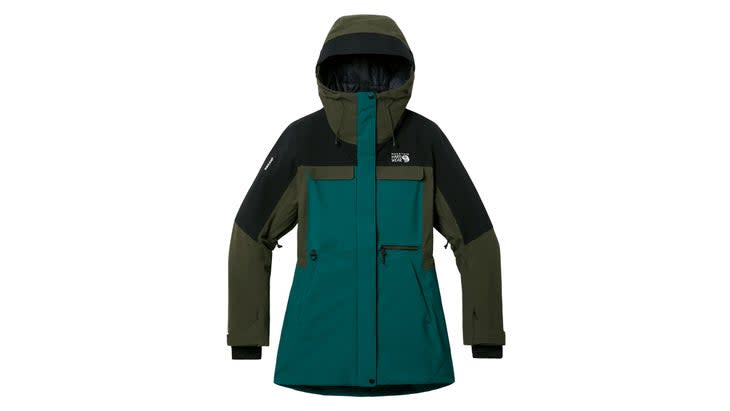
Weight: 2.2 lbs
Sizes: XS-XL
Pros
Unique looking
Long cut covers your butt
Cons
Several mostly unusable pockets
No real phone pocket
Mid-priced, lightly insulated, with a bold look and freeride cut, the Powder Maven Parka was lauded for its attitude, its butt-covering waterproofness, and its tailored insulation throughout. Generously cut to leave plenty of room to move without being a sack, the Powder Maven used body-mapped insulation that kept Vermont-based Louise Lintilhac "warm even when the wind was cutting." In lift lines in multiple states, including Stowe, Vt., and Crested Butte, Colo., Lintilhac got compliments on this color-blocked but not flashy jacket that's eye-catching without being obnoxious. "The baggy fit and longer cut were flattering," said Lintilhac. "And when it was deep, I loved that I could button the powder skirt to the Powder Maven bibs to keep the snow out." The helmet-compatible hood had three-way drawcord adjustment that kept us seeing clearly in a storm. And underarm zip vents with mesh backing let us dump heat while keeping snow out on blower days. An interior chest pocket proved the perfect spot to store a phone. Phones also fit in the Velcro chest pockets, but we didn't want to ski with them there because the pockets didn't zip. A skin pocket was the perfect place to store goggles and gloves when we weren't using them. Lycra cuffs have thumb loops and the jacket cuffs have a gusseted opening to make it easier to slide glove cuffs inside.
Bottom line: This is a mid-priced jacket that will keep you looking and feeling good on greens, blues, blacks, and beyond.
Best Anorak: Outdoor Research Snowcrew Anorak ($329)
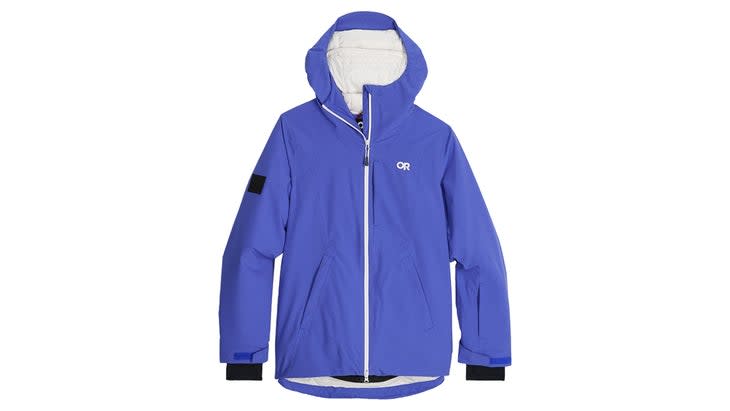
Weight: 1.9 lb
Sizes: XS-XXL
Pros
Deep chest zipper
Kangaroo and handwarmer pockets
Cons
No pass pocket in the sleeve
Not very stretchy
Anoraks have a unique style on the slopes, and this one ups the eco-friendly ante with 60 grams of partially recycled polyester insulation that's warmer, stretchier, and more breathable than most polyester insulation. Testers loved the way soft polyester shell anorak looked, with bright zippers, a colorful lining, and playful color blocking that stood out against the monotone of winter.
Sometimes anoraks can feel confining, but not this one. A deep chest zip made it easy to get on and off. The zipper is covered with a wind flap to keep you toasty inside. And pit zips assist with venting on hot days. The fit was spot on, able to accommodate one tester's wider shoulders, not too baggy, not too tight. It's cut to mid-butt length which was warm skiing, but not so long as to feel like it was cramping anyone's style. Lycra inner cuffs prevented snow from getting up one tester's sleeves on a chest-deep powder day at Utah's Solitude Mountain Resort.
A fleece-lined kangaroo pocket stashed goggles as well as lunch, apres drinks, and gloves, and there was still space to warm up cold fingers in the pass-through handwarmer pocket underneath. The jacket is seam sealed, and it's made for carving turns in frozen water on cold days. Bonus: the hood is insulated too.
Bottom line: This is a great value, fun and functional pullover that will keep you warm on the slopes.
How to Buy Women's Resort Jackets
The very best way to buy a jacket is to try on several and buy the one that fits and feels best. Whether you're shopping in-store or online, here are our pointers for picking a ski jacket you'll love:
Choose insulated, or not. First, determine how cold it will be where you ski, and if you want an insulated jacket, or you want to layer up underneath a shell. An insulated jacket will require less layering, and it may feel cozier than a shell, but it may not work as well for warmer weather skiing.
Find your fit. We're all built differently, and every manufacturer cuts the size small, medium, or large to their own specs, not an industry standard. So don't be surprised if you're a small in one brand, and a large in another. Whenever possible, try before you buy. That will also help you hone in on if you prefer a more tailored or a freeride fit, and whose pants fit your curves best.
Check the features. If you need a pass pocket to get through the gates at your home resort, get a jacket that has one on the arm. If you're a storm skier, you probably want a powder skirt. And If you want easy phone access for tunes or photos, be sure to pick a jacket where the pockets work for you. Not every jacket has every feature. Think about what's most important for you, and get a jacket with the features to deliver.
Stick to your budget. Ski shells run the gamut when it comes to pricing. If you want to splurge or price isn't an object, there are many options. If you're on a budget, don't stress. You can still get a great jacket.
How We Test
Number of testers: 19
Number of Products Tested: 45
Number of Days on Snow: 846
U.S. States Tested In: 8 (plus 4 other countries)
The goal: To get as many different types of jackets tested by as many different types of skiers in as many different conditions as possible. To do so, box up gear and send it all over the country: Vermont, Utah, Wyoming, Idaho, Colorado, Montana, and New Mexico. Then we hit the slopes, the side country, and the backcountry and we took notes, lots of them. We noted the temperature and how warm we felt, if the jacket covered our butts, if we felt free or cramped as we arced down the mountain or pulled ourselves up from a powdery wipeout. We noted how well the jacket protected us from weather, if it was breathable or not, if we had the pockets we needed. And when we got compliments in the lift line, we noted that too. We wore all 46 jackets at ski resorts across the U.S., and we also wore them for everyday activities we found ourselves doing throughout the winter, from grocery shopping to mountaineering. We're women from 23 to 59. Some of us are expert skiers and ski professionals. Some are full-time moms who shred. Some of us are weekend warriors and dawn patrollers who get laps in before work and after hours. All of us love to ski whenever, wherever, and however we can.
Meet Our Testers
Berne Broudy is a Vermont-based skier who calls Stowe Mountain Resort her home hill, though she spends as much time in the backcountry as possible. Broudy has been reporting on environmental issues, gear, and travel for two decades. She's developed and guided hiking and cycling trips all over the U.S. and South America. She's led students through Ghana and Peru, and she's biked across the U.S. She's had fat biking first descents in Alaska, she helped establish the first sport climbing in East Greenland, and she was on the first female team to traverse the country of Jordan by bike. She skis every day there's snow on the trails behind her house, and clocks resort days and backcountry days anytime and anywhere she can, from Vermont to Japan and all points in between.
Louise Lintilhac is a former Freeski World Tour contestant. She filmed for four seasons with Meathead Films and still strives to spend 80 days a year at the resort and in the backcountry. Though she's logged thousands of ski days in her 38 years, one stands out: lapping Alta with Angel Collinson, Eric Hjorleifson, and Zach Giffin. There was three feet of fresh powder, and it had snowed around three feet and Lintilhac had a 102degF fever. She popped some Chloraseptic in her pocket, and skied her face off.
Bec Wojtecki is a former nurse, executive director of a community trails non-profit, and a mom. She spends most of her ski days showing her kids, Lucca and Drew, the slopes. Born and raised on the East Coast, Bec, who calls herself an intermediate skier, loves to lap the fast corduroy and try to keep up with her kids. "My favorite thing about skiing is that it's so easily shared with friends and family," says Wojtecki. When not skiing, mountain biking, or fundraising, she can be found hiking with her Great Dane mix pup, working in the garden, and building Legos with Lucca and Drew.
More From the 2024 Winter Gear Guide
The Best Women's All-Mountain Skis
The Best Women's Alpine Ski Boots
The Best Goggles of 2024
For exclusive access to all of our fitness, gear, adventure, and travel stories, plus discounts on trips, events, and gear, sign up for Outside+ today.

